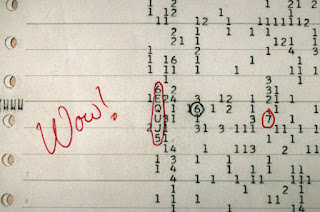SETI@home
The 1990’s was a decade of PlayStations, Britpop culture and the rise of internet activity. However, whilst I was struggling getting to grips with Lara Croft (tomb raiding of course) and listening to Blur, SETI (searching for extra-terrestrial intelligence) launched an online project called SETI@home in 1999. This meant home computer users could download raw telescopic data and transform this into something meaningful, perhaps an alien transmission? Over the years spurious candidate signals have been detected and out ruled as background terrestrial interference and dead ends.
SETI@home now operates under a larger umbrella called ‘breakthrough listen’ as a part of the wider ‘breakthrough initiatives’ project. Most recently, users finally detected a signal which serves as our first signal candidate in almost 22 years of searching and listening. This is referred to as BLC1 (breakthrough listen candidate-1) and has scientists baffled for answers.
The first baffling aspect of this signal is the location. It was discovered to emanate from our nearest star Proxima Centauri, approximately 4.1 light years away. Secondly, the frequency of the signal appears to blue shift suggesting that the origin of the signal is moving towards us!
Figure 1: A depiction of the doppler effect, as the signal is 'blue shifted' it is therefore moving towards us.
We are currently aware that Proxima Centauri has one confirmed planet called Proxima-b. Some scientists believe that this maybe a natural signal emanating from the planet as is orbited towards our own star then orbited away periodically, this would explain the observed blue shift within the signal and is referred to as the doppler effect. In fact, astronomers use this effect to indirectly discover planets in nearby star systems such as Proxima Centauri.
However, this leads to the second most puzzling aspect, the signal has yet to repeat. When looking for deliberate techno signatures scientists often look for repeating signals. Most our own satellites in orbit of Earth repeat signals back and forth when transmitting data. However, no known satellites were in the vicinity of the night sky during the thirty-hour time frame this signal was detected.
The frequency of transmission is also puzzling. It measured at exactly 982 MHz-1. Hertz (Hz) is a measure of oscillations per second. For this signal to be an exact number almost implies a civilisation would be familiar with seconds, yet seconds is a human construct of time.
Also, 982 MHz-1 is an unusual frequency to broadcast a deliberate signal on. Scientifically, it is accepted that we would likely observe an extra-terrestrial signal at 1.4 GHz-1, often called the ‘watering hole’ frequency. This is because hydrogen being the most common element within the observable universe emits radiation at this frequency, this is called hyperfine coupling:
Figure 2: Hyperfine coupling of hydrogen. This process is extremely slow (cosmologically). Therefore this particular frequency is quiet and perfect for extra-terrestrial transmissions.
The assumption is that should an advanced civilisation wish to make a deliberate communications attempt, this frequency would be ideal as it is a quiet frequency. We would also expect such a civilisation to be aware of the vast abundance of hydrogen. In fact, it is strictly prohibited under international treaty to broadcast terrestrially on this signal for this particular reason.
In my opinion, I feel this is too good to be true. The idea of there being an advanced civilisation 4.2 light years away whilst tantalising close, seems somewhat far fetched given the proximity. This would also mean that the entire galaxy could be teeming with civilisations making similar ‘phone calls’, with which we have yet to detect.
However, I would love to be proved wrong. Perhaps an advanced civilisation is using Proxima Centauri as a ‘relay station’ to say a simple hello? Many scientists have compared BLC1 to that of the WOW! signal recorded in 1977 which also remains unexplainable. Both of these signals are now the strongest candidates for possible extra-terrestrial communication.
As a result, the unexplainable nature of BLC1 further fuels the idea of ‘breakthrough starshot’. Here, it has been postulated that tiny cameras with solar sails will make a fly by mission to Proxima Centauri at 20% of the speed of light with the hopes of sending data back to Earth.
More closer to home and similar to the Oddworld games that featured on the PlayStation, perhaps BLC1 is a signal from Abe of the enslaved Mudokan race simply saying ‘Get me outta here!” as he frantically flees Rupture Farms and the tyranny of the Glukkon race.






Comments
Post a Comment